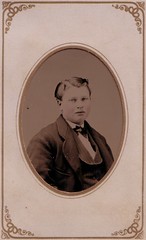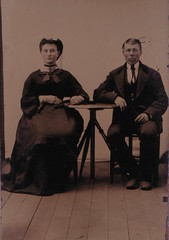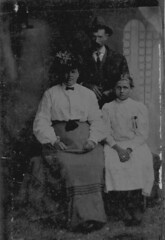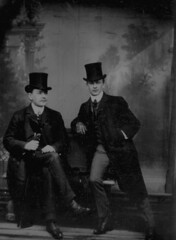Difference between revisions of "Ferrotype"
m |
(Links to old auction catalogue listings of Ferrotype cameras; added to caption. Moved text up.) |
||
| Line 1: | Line 1: | ||
| + | <div class="floatright plainlink" style="margin:0px 0px 10px 15px;"> | ||
{{Flickr_image | {{Flickr_image | ||
|image_source= http://www.flickr.com/photos/library_of_congress/3549666828/ | |image_source= http://www.flickr.com/photos/library_of_congress/3549666828/ | ||
| − | |image= http://farm4.static.flickr.com/3573/ | + | |image= http://farm4.static.flickr.com/3573/3549666828_e562294d13_z.jpg |
| − | |image_align= | + | |image_align= |
| − | |image_text= | + | |image_text= Tintype street photographer. The cylinder behind<br/>the photographer's wrist is the developing tank. |
| − | |image_by= Shahn | + | |image_by= Ben Shahn |
|image_rights= public domain | |image_rights= public domain | ||
| − | }}{ | + | }} |
| + | </div> | ||
| + | '''Ferrotypes''' (also known {in the USA} as '''Tintypes''') are photographs made onto black-enamelled iron plates by the [[wet-collodion ]]process. The black background made the transparent areas of the negative image appear black, and the dark, silvered areas were whitened using mercuric bichloride, and so appear light - in the same way as glass [[Ambrotype]]s. | ||
| + | |||
| + | French photographer Adolphe A Martin was the first to use this process, in 1853. | ||
| + | A dry ferrotype processes later replaced the wet-plate system. | ||
| + | As the process could be carried out inside the camera and needed no drying time, dry ferrotypes were popular with "while-you-wait" beach and street photographers<ref>''Focal Encyclopedia of Photography'', Focal Press, 1976 edition, p.588</ref>. Some cameras were advertised specifically for this purpose, such as the [[Mandel-ette]]. | ||
| + | |||
| + | Since the image must be viewed from the silvered side of (non-transparent!) plate, the image is left-right reversed (mirror-imaged) - a fault shared with most [[Daguerreotype Process|Daguerreotypes]]. | ||
| + | |||
| + | The process was used in the US until the early 1940s. | ||
| + | |||
| + | |||
{|class=plainlinks | {|class=plainlinks | ||
||[http://www.flickr.com/photos/89864432@N00/3288940544/in/pool-camerapedia http://farm4.static.flickr.com/3250/3288940544_9cb4c98c78_m.jpg] | ||[http://www.flickr.com/photos/89864432@N00/3288940544/in/pool-camerapedia http://farm4.static.flickr.com/3250/3288940544_9cb4c98c78_m.jpg] | ||
| Line 14: | Line 27: | ||
||[http://www.flickr.com/photos/89864432@N00/3690823553/in/pool-camerawiki http://farm4.static.flickr.com/3644/3690823553_226787508c_m.jpg] | ||[http://www.flickr.com/photos/89864432@N00/3690823553/in/pool-camerawiki http://farm4.static.flickr.com/3644/3690823553_226787508c_m.jpg] | ||
|- | |- | ||
| − | || | + | ||Young American |
||American couple | ||American couple | ||
||American family | ||American family | ||
| − | || | + | ||Two gentlemen |
| − | || | + | ||Two young ladies |
|} | |} | ||
| − | + | {{Br}} | |
| − | + | <references /> | |
| − | |||
| − | |||
| − | |||
| − | |||
| − | |||
| − | |||
| − | |||
| − | |||
| + | ===Links=== | ||
| + | Ferrotype cameras in a past Breker auction catalogue: | ||
| + | * [http://www.liveauctioneers.com/item/8777595 Aptus], for 1¾×2½ inch exposures, by Moore & Co. of Liverpool, c.1910. | ||
| + | * [http://www.liveauctioneers.com/item/8777596 One Minute Camera], by the One Minute Camera Co. of Chigago, 1910-20. | ||
| + | * [http://www.liveauctioneers.com/item/8777597 Mandel-ette], by the Chicago Ferrotype Co., c.1914. | ||
| + | * [http://www.liveauctioneers.com/item/8777598 Unidentified street camera] for ferrotype and postcards, c.1910. | ||
[[Category: Photographic processes]] | [[Category: Photographic processes]] | ||
Revision as of 13:34, 4 August 2011

|
| Tintype street photographer. The cylinder behind the photographer's wrist is the developing tank. image by Ben Shahn (Image rights) |
Ferrotypes (also known {in the USA} as Tintypes) are photographs made onto black-enamelled iron plates by the wet-collodion process. The black background made the transparent areas of the negative image appear black, and the dark, silvered areas were whitened using mercuric bichloride, and so appear light - in the same way as glass Ambrotypes.
French photographer Adolphe A Martin was the first to use this process, in 1853. A dry ferrotype processes later replaced the wet-plate system. As the process could be carried out inside the camera and needed no drying time, dry ferrotypes were popular with "while-you-wait" beach and street photographers[1]. Some cameras were advertised specifically for this purpose, such as the Mandel-ette.
Since the image must be viewed from the silvered side of (non-transparent!) plate, the image is left-right reversed (mirror-imaged) - a fault shared with most Daguerreotypes.
The process was used in the US until the early 1940s.

|

|

|

|

|
| Young American | American couple | American family | Two gentlemen | Two young ladies |
- ↑ Focal Encyclopedia of Photography, Focal Press, 1976 edition, p.588
Links
Ferrotype cameras in a past Breker auction catalogue:
- Aptus, for 1¾×2½ inch exposures, by Moore & Co. of Liverpool, c.1910.
- One Minute Camera, by the One Minute Camera Co. of Chigago, 1910-20.
- Mandel-ette, by the Chicago Ferrotype Co., c.1914.
- Unidentified street camera for ferrotype and postcards, c.1910.